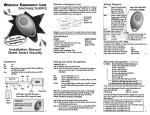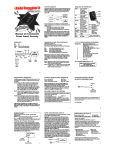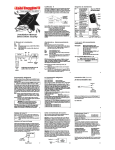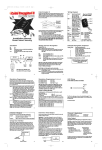Download MOOSE Z900 Specifications
Transcript
WIRELESS EMERGENCY LINE Patent Pending - Part #WEL-Y Wireless Emergency Line Wiring Diagram Location of the control module is the most important determining factor for range and reliability of your Wireless Emergency Line. Select a location that is as centrally located as possible. Keep in mind that your customer will want to control the operation of the garage door from the driveway, and will also expect the use of the remote for alarm On/Off in the area of entry and exit. Yellow Recommended placement for Wireless Emergency Line Attic Bedroom Point of Entry Connect to yellow of keypad *Moose panels connect to white of keypad Green Connect to green of keypad Brown Relay Common (5amp) Brown/White Relay N/O Garage (5amp) Basement Blue/Green Relay N/C (5amp) Although you can wire at the panel, it may reduce labor and increase range by installing the Wireless Emergency Line receiver at the point of entry or near a keypad. Specifications ith Now w larm atic A Automognition Rec RECEIVER • 12VDC Power Input • Selectable: Form C Relay (N/O, N/C, Comm) 5amp • Channel 1 - Keypad panic data output (Programmable Medial/Panic) Frequency 303Mhz Stand by Power Consumption 15ma Temperature Range -5°F to 160°F (Indoor use only) Installation Manual Street Smart Security REMOTE CONTROL Battery (2) CR1616Lithium Range 75-100 feet Installation Wiring and Auto Recognition Red Black Yellow Green COMPLETE STEPS 1-5 Step 1) Unplug the receiver from the wire harness. Step 2) Wire the Red, Black, Yellow and Green to the keypad. Aux + Aux Keypad Data Line Keypad Data Line Black RED BLACK GREEN YELLOW Red Alarm Panel WEL + Aux Yellow Jumpers 1 2 3 4 5 6 7 8 9 Alarm Keypad Program Button Optional 2 button remote for both Medical and Police on one remote. Connect to Keypad Red or Aux (+) Connect to Keypad Black or Aux (-) Connect to Keypad Green Connect to Keypad Yellow *Moose ZX200/400/900/950 Connect to the White wire. Part # CEREM2 3 Black (-) Ground Press and release for relay mode, press and hold for 3 seconds for PANIC output. Relay can be wired to any zone for an additional panic output. Programming the WEL To change from Panic to Medical or to change from Delay to Instant activation locate the two jumpers next to the wire harness. Jumper closest to the harness IN (Default) Panic Jumper closest to the harness removed Medical Jumper farthest from the harness IN (Default) Delay Activation Jumper farthest from the harness removed Instant Activation 2 No. of Flashes Alarm Panel detected by the Wireless Emergency Line 1 No Alarm connected (WEL defaults to relay mode) SEE PAGE 7 “Default Mode” 2 Napco 1000E Series (including 1008E, 1016E, etc.) 3 Moose Z880/Z900/Z950 4 Caddx 8600E, 8980E 5 Ademco Non Addressable 6 Ademco Addressable 7 DSC 1555/1565/5010 (Power 832)/5015/580 8 DSC 1550, 2525, 2550, 3000 9 Moose ZX200/ZX300/ZX400 10 Moose Z1100E, ADT A910 11 12 Moose Z1100 Step 3) Make sure the alarm panel is powered up and operating. Step 4) While watching the LED light on the Control module, plug the receiver into the Wireless Emergency Line harness. Step 5) The LED will blink 1 time on power up, after 2 seconds COUNT the flashes that you see. The corresponding flashes will indicate which panel the Wireless Emergency Line has detected. Options +12VDC Automatic Recognition Continued: NOTE: You can make these connections at the panel or at the keypad itself. If you place the Wireless Emergency Line in the garage or any other location away from the panel you may choose to wire the Wireless Emergency Line directly to the keypad. LED Green 1 Red 4 NOTE: If the WEL does not detect correctly, call Technical Toll Free 888-768-2846 7am-5pm PST * Please verify the panel is programmed for keypad PANIC or Medical, whichever is being used. The WEL on the following panels self enrolls as a specific keypad address code. • Ademco addressable Address #3 • Moose ZX200/ZX400 addressable Address #4 DO NOT USE ANY OF THESE ADDRESS CODES IF YOU ARE USING ONE OF THE ABOVE PANELS. EXAMPLE: If you are using an Ademco Addressable, no keypads can use address #3 since the WEL will automatically enroll itself as address #3. 5 Relay Application Press and Release button Press and Hold button 3 for seconds Relay Output Panic Mode Relay Output This output is a 5amp Form C relay (Common, N/O/, N/C). To energize relay, press and release remote button. You must RELEASE the button before the relay will energize. This can be wired to any zone for any response type. To Add or Delete Remotes TO ADD A NEW REMOTE To add a remote to your Wireless Emergency Line PRESS AND RELEASE the program button on the receiver. The light on the receiver will come ON. Immediately PRESS the button on the new remote control THREE TIMES. The light on the receiver should go OFF, indicating the remote has been learned. If the light on the receiver stays ON, the remote has not been learned. Remove and replace the harness, wait 15 seconds while auto recognition occurs and follow these instructions again. DEFAULT MODE: • If the WEL fails to recognize any of the data coming from the keypad wires, it will automatically default to a relay mode • If this happens, verify that you are properly wired to one of the alarms listed on page 5. • If you have connected the WEL to an alarm it does not recognize, follow the wiring below to set relay to a zone programmed for panic. • Do not use the green or yellow wires. Hardwiring a Zone Red Black Brown/White Brown Street Smart Limited Warranty Street Smart, a Division of Pittway Corporation, and it’s divisions, subsidiaries and affiliates (“Seller”), 12800 Brook Printer Place, Poway, California 92064, warrants its products to be in conformance with its own plans and specifications and to be free from defects in materials and workmanship under normal use and service for 24 months from the date stamp control on the product or, for products not having a Street Smart date stamp, for 12 months from date of original purchase unless the installation instructions or catalog sets forth a shorter period, in which case the shorter period shall apply. Seller's obligation shall be limited to repairing or replacing, at it s option, free of charge for materials or labor, any product which is proved not in compliance with Seller's specifications or proves defective in materials or workmanship under normal use and service. Seller shall have not obligation under this Limited Warranty or otherwise if the product is altered or improperly repaired or serviced by anyone other than Street Smart factory service. For warranty service, return product transportation prepaid, to Street Smart Factory Service, 12800 Brook Printer Place, Poway, California 92064. THERE ARE NO WARRANTIES, EXPRESS OR IMPLIED, OF MERCHANTABILITY, OR FITNESS FOR A PARTICULAR PURPOSE OR OTHERWISE, WHICH EXTEND BEYOND THE DESCRIPTION ON THE FACE HEREOF. IN NO CASE SHALL SELLER BE LIABLE TO ANYONE FOR ANY CONSEQUENTIAL OR INCIDENTAL DAMAGES FOR BREACH OF THIS OR ANY OTHER WARRANTY, EXPRESS OR IMPLIED, OR UPON ANY OTHER BASIS OR LIABILITY WHATSOEVER, EVEN IF THE LOSS OR DAMAGE IS CAUSED BY THE SELLER'S OWN NEGLIGENCE OR FAULT. Seller does not represent that the products it sells may not be compromised or circumvented; that the products will prevent any personal injury or property loss by burglary, robbery, fire or otherwise; or that the products will in all cases provide adequate warning or protection. Customer understands that a properly installed and maintained alarm may only reduce the risk of a burglary, robbery, fire or other events occurring without providing an alarm, but it is not insurance or a guarantee that such will not occur or that there will be no personal injury or property loss as a result. CONSEQUENTLY, SELLER SHALL HAVE NO LIABILITY FOR ANY PERSONAL INJURY, PROPERTY DAMAGE OR OTHER LOSS BASED ON A CLAIM THE PRODUCT FAILED TO GIVE WARNING. HOWEVER, IF SELLER IS HELD LIABLE, WHERE DIRECTLY OR INDIRECTLY, FOR ANY LOSS OR DAMAGE ARISING UNDER THIS LIMITED WARRANTY OR OTHERWISE, REGARDLESS OF CAUSE OR ORIGIN, SELLER'S MAXIMUM LIABILITY SHALL NOT IN ANY CASE EXCEED THE PURCHASE PRICE OF THE PRODUCT, WHICH SHALL BE THE COMPLETE AND EXCLUSIVE REMEDY AGAINST SELLER. This warranty replaces any previous warranties and is the only warranty made by Seller or this product. No increase or alteration, written or verbal, of the obligations of this Limited Warranty is authorized. 9 2) Verify that the remote is programmed into the WEL module. GO TO page 6 and teach the remote. 3) Is the panel programmed for Silent Panic? Maybe it is operating but you are not hearing it. Red Alarm Panel The WEL can hold up to seven remotes. TO DELETE ALL REMOTES To delete a lost or stolen remote from the Wireless Emergency Line, you must purge the entire memory. This will delete all of the current remotes. You will then have to add them back into memory. To purge, PRESS AND HOLD the program button, the light will come ON for four seconds, then go OFF, and finally it will come ON again, indicating that all the remotes in memory have been purged. Release the program button and 6 follow the instructions above (To Add a New Remote). PROBLEM: I press and hold button on remote but there is no panic. SOLUTION: 1) Make sure the panel is programmed to accept keypad panic STREET SMART SECURITY TECHNICAL CAN BE REACHED AT: 12800 Brook Printer Place, Poway, CA 92064 M-F 7AM-5PM PST AT (888) 768-2846 OR (619) 513-9352-FAX Aux + Aux Zone programmed for any response (Panic/Medical) Common adjacent to zone Black Troubleshooting WEL Zone programmed for panic Resistor should be in-line OR across the zone, whichever clears the zone. Brown Brown/White NOTE: Blue/Green should be used instead of Brown/White for N/C application. 7 8 Federal Communications Commission (FCC) Statement Canadian Department of Communications (DOC) Statement This equipment has been tested to FCC requirements and has been found acceptable for use. The FCC requires the following statement for your information: This equipment generates and uses radio frequency energy and if not installed and used properly, that is, in strict accordance with the manufacturer's instructions, may cause interference to radio and television reception. It has been type tested and found to comply with the limits for a Class B computing device in accordance with the specifications in Part 15 of FCC Rules, which are designed to provide reasonable protection against such interference in a residential installation. However, there is no guarantee that interference will not occur in a particular installation. If this equipment does cause interferences to radio or television reception , which can be determined by turning the equipment off and on, the user is encouraged to try to correct the interference by one or more of the following measures: • If using an indoor antenna, have a quality outdoor antenna installed. • Reorient the receiving antenna until interference is reduced or eliminated • Move the receiver away from the control/communicator. • Move the antenna leads away from any wire runs to the control/communicator. • Plug the control/communicator into a different outlet so that it and the receiver are on different branch circuits. If necessary, the user should consult the dealer or an experienced radio/television technician for additional suggestions. The user or installer may find the following booklets prepared by the Federal Communications Commission helpful: “Interference Handbook” This booklet is available from the U.S. Government Printing Office, Washington, DC 20402. The user shall not make any changes or modifications to the equipment unless authorized by the installation instructions or User’s Manual. Unauthorized changes or modifications could void the user’s authority to operate the equipment. NOTICE: The Canadian Department of Communications label identifies certified equipment. This certification means that the equipment meets certain telecommunications network protective, operational and safety requirements. The Department does not guarantee the equipment will operate to the user's satisfaction . Before installing this equipment, users should ensure that it is permissible to be connected to the facilities of the local telecommunications company. The equipment must also be installed using an acceptable method of connection. In some cases, the company's inside wiring associated with a single line individual service may be extended by means of certified connector assembly (telephone extension cord). The customer should be aware that compliance with the above conditions may not prevent degradation of service in some situations. Repairs to certified equipment should be made by an authorized Canadian maintenance facility designed by the supplier. Any repairs or alterations made by the user to this equipment, or equipment malfunctions, may give the telecommunications company cause to request the user to disconnect the equipment. Users should ensure for their own protection that the electrical ground connections of the power utility, telephone lines and internal metallic water pipe system, if present, are connected together. This precaution may be particularly important to rural areas. CAUTION: User should not attempt to make such connections themselves, but should contact the appropriate electric inspection authority, or electrician, as appropriate. The Load Number (LN) assigned to each terminal device denotes he percentage of the total load to be connected to a telephone loop which is used by the device, to prevent overloading. The termination on a loop may consist of any combination of devices subject only to the requirement that the total of the Load Numbers of all the devices does not exceed 100. 11 10












